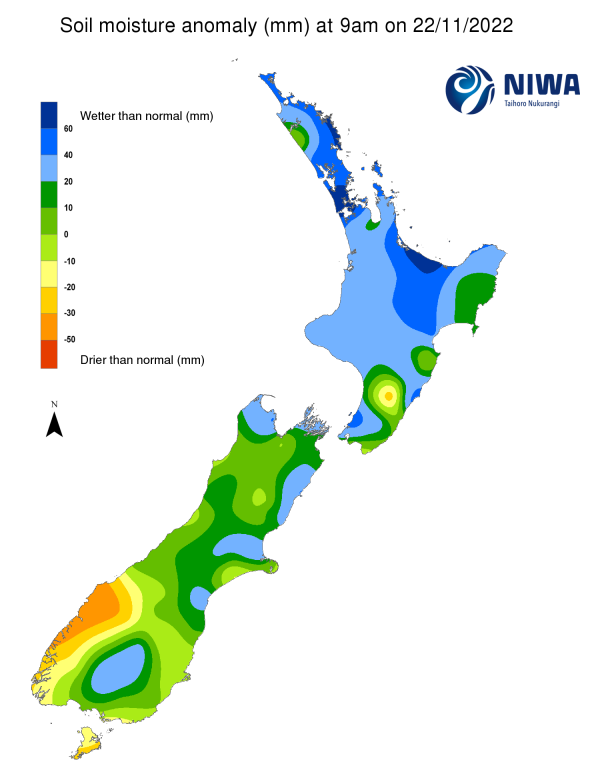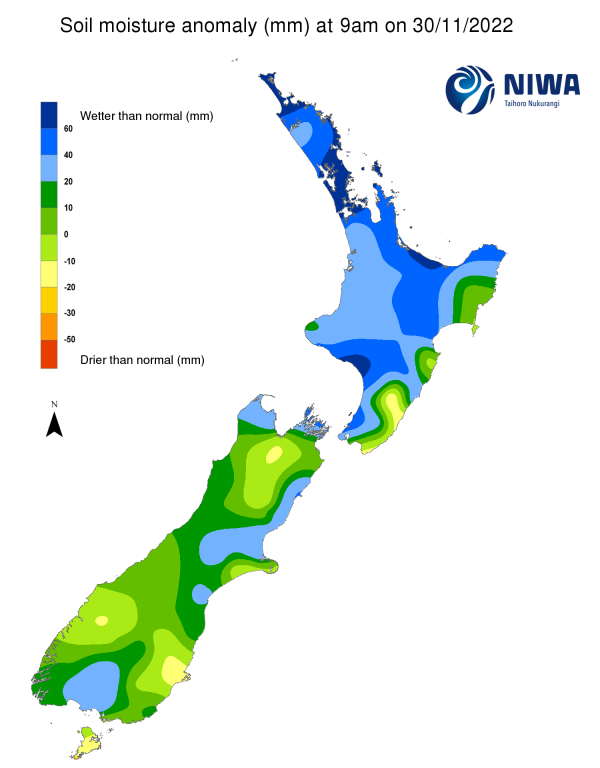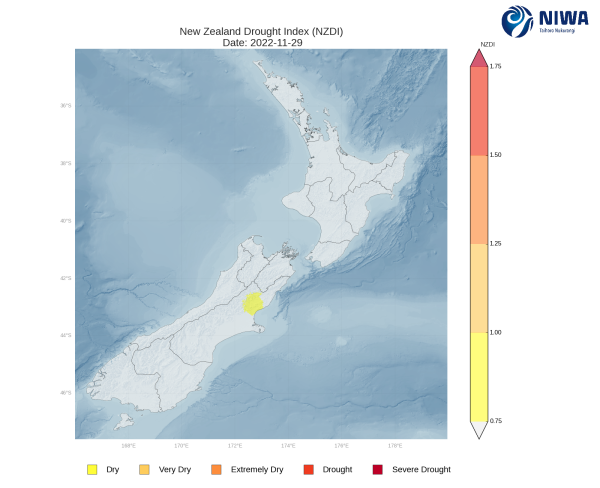A weekly update describing soil moisture patterns across the country to show where dry to extremely dry conditions are occurring or imminent. Regions experiencing significant soil moisture deficits are deemed “hotspots”. Persistent hotspot regions have the potential to develop into drought.
Facts: Soil Moisture
In the North Island, substantial rainfall accumulations were observed in the past week in western and central regions. Widespread amounts of 50-75 mm were observed here, with pockets of 100 mm or more in the Central Plateau and western Waikato. Parts of Northland and Auckland received more than 30 mm. However, much lighter rainfall amounts were observed in the Far North, coastal Bay of Plenty, and the entire east coast, where rainfall totals only reached 10-25 mm. This resulted in additional soil moisture increases for most central and western regions along with parts of Northland. Slight soil moisture decreases were observed along the east coast. The driest soils across the North Island, when compared to normal for this time of the year, are found in coastal Wairarapa, while the wettest soils for this time of the year are found in Northland, Auckland, coastal Bay of Plenty, and coastal Manawatū-Whanganui.
No hotspots are currently located in the North Island.
In the South Island, moderate to heavy rain fell along the West Coast in the past week, with many areas receiving 50-100 mm. Significant rainfall also occurred in much of interior Canterbury, with some areas receiving 30-50 mm. Lesser amounts were observed in Nelson, Marlborough, coastal Canterbury, much of Otago, and Southland, where rainfall totals were generally 15-25 mm. This generally resulted in little change to the soil moisture situation across the South Island, although moderate increases were observed in Fiordland and the lower West Coast. The driest soils in the South Island, when compared to normal for this time of the year, are located near Dunedin, while the wettest soils for this time of the year are found in Tasman, Marlborough Sounds, north coastal Canterbury, and parts of Southland.
No hotspots are currently located in the South Island. As of 28 November, the New Zealand Drought Index (NZDI) map below shows that dry conditions are located in a portion of north-central Canterbury.
Outlook and Soil Moisture
In the North Island, high pressure approaching from the Tasman Sea will bring generally dry weather over the coming days, with a few exceptions. On Friday and Saturday (2-3 December), an onshore wind flow will bring some showers to the east coast, while the western North Island may see light showers beginning around Tuesday (6 December). Overall, only light rainfall is expected in the North Island during the next week. Weekly rainfall totals of 5-15 mm are expected for most locations, although parts of the east coast may receive up to 20 mm.
Due to the expected rainfall in the next week, at least small soil moisture decreases are likely across most of the North Island, although little change is expected in the east coast. No hotspots are expected to form in the North Island in the next week.
In the South Island, the east coast is likely to see showers on Friday (2 December), followed by a front bringing some rain to Southland and Fiordland on Sunday (4 December). These same areas will see additional rain on Tuesday (6 December), with the possibility for more substantial rain in the West Coast on Thursday. Weekly rainfall totals may reach 50-100 mm in the lower West Coast and Fiordland, with much of Southland receiving up to 40 mm. While parts of Canterbury could receive 20-25 mm, most of the upper South Island will receive 15 mm or less.
Due to the expected rainfall in the next week, soil moisture levels will likely decrease at least slightly in the upper South Island. Meanwhile, at least small increases are likely in the lower South Island. No hotspots are expected to form in the next week.
Background:
Hotspot Watch: a weekly advisory service for New Zealand media. It provides soil moisture and precipitation measurements around the country to help assess whether extremely dry conditions are imminent.
Soil moisture deficit: the amount of water needed to bring the soil moisture content back to field capacity, which is the maximum amount of water the soil can hold.
Soil moisture anomaly: the difference between the historical normal soil moisture deficit (or surplus) for a given time of year and actual soil moisture deficits.
Definitions: “Extremely” and “severely” dry soils are based on a combination of the current soil moisture status and the difference from normal soil moisture (see soil moisture maps at https://www.niwa.co.nz/climate/nz-drought-monitor/droughtindicatormaps)
Hotspot: A hotspot is declared if soils are "severely drier than normal" which occurs when Soil Moisture Deficit (SMD) is less than -110 mm AND the Soil Moisture Anomaly is less than -20 mm.


Pictured above: Soil Moisture Anomaly Maps, relative to this time of year. The maps show soil moisture anomaly for the past two weeks.
New Zealand Drought Index (NZDI)
As of 28 November, the New Zealand Drought Index (NZDI) map below shows that dry conditions are located in a portion of north-central Canterbury. Please note: some hotspots in the text above may not correspond with the NZDI map. This difference exists because the NZDI uses additional dryness indices, including one which integrates the rainfall deficit over the past 60 days. Changes are therefore slower to appear in the NZDI compared to soil moisture anomaly maps that are instantaneously updated.


